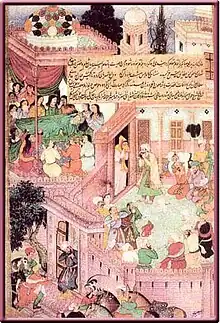 A page from Tarikh-i-Khandan-i-Timuriyah This painting depicts the death of Timur, Hazrat-i-Sahib-i-Qiran | |
| Author | Akbar |
|---|---|
| Country | India |
| Language | Persian |
| Series | Persian literature |
| Subject | Historical record |
| Genre | Historical Memoir |
Publication date | 16th century |
| Media type | Book |
| Pages | 338 |
Tarikh e Khandan e Timuriyah also known as "Chronicle of the Descendants of Timur" is a 16th-century manuscript which was prescribe by Mughal Emperor Akbar.[1] It gives the details about the descendant of Timur in Iran and India[2] It was produced during Emperor Akbar's reign in 1577–1578, this volume was crafted for the emperor's personal use thus, securing a treasured place in his personal library. This volume, was inscribed on the finest paper, boasts a collection of 133 paintings, collaboratively crafted by 51 prominent artists like Daswant, Miskin, Madho Mukund, Haidar Kashmiri, Miskeen, Manohar and Basawan.[3] These intricately detailed and refined paintings exemplify the pinnacle of Mughal artistic expression.[4] The written text has calligraphy that matches the standards set by the artwork.
It was inducted in the UNESCO Memory of the World in 2011.[2] The original manuscript is preserved in the Khuda Bakhsh Oriental Public library.[5][6]
It is the only extant copy of a manuscript that deals with the history of Timur and his descendants in Iran and India, including the Mughal rulers Babur, Humayun and Akbar.
References
- ↑ "Tarikh-E-Khandan-E-Timuriyah". INDIAN CULTURE. Retrieved 2023-07-11.
- 1 2 "Tarikh-E-Khandan-E-Timuriyah | Silk Roads Programme".
- ↑ "Rare manuscript most exquisite cultural history of Timurids: Unesco". The Times of India. 2012-02-01. ISSN 0971-8257. Retrieved 2023-07-11.
- ↑ "Exhibition of rare manuscripts paintings from Patna's Khuda Bakhsh Library held in Delhi". The Week. Retrieved 2023-07-11.
- ↑ "Tarikh-E-Khandan-E-Timuriyah". MOWCAP ARCHIVE. Retrieved 2023-07-11.
- ↑ "Khuda Bakhsh library to publish catalogue". The Times of India. 2012-07-16. ISSN 0971-8257. Retrieved 2023-07-11.